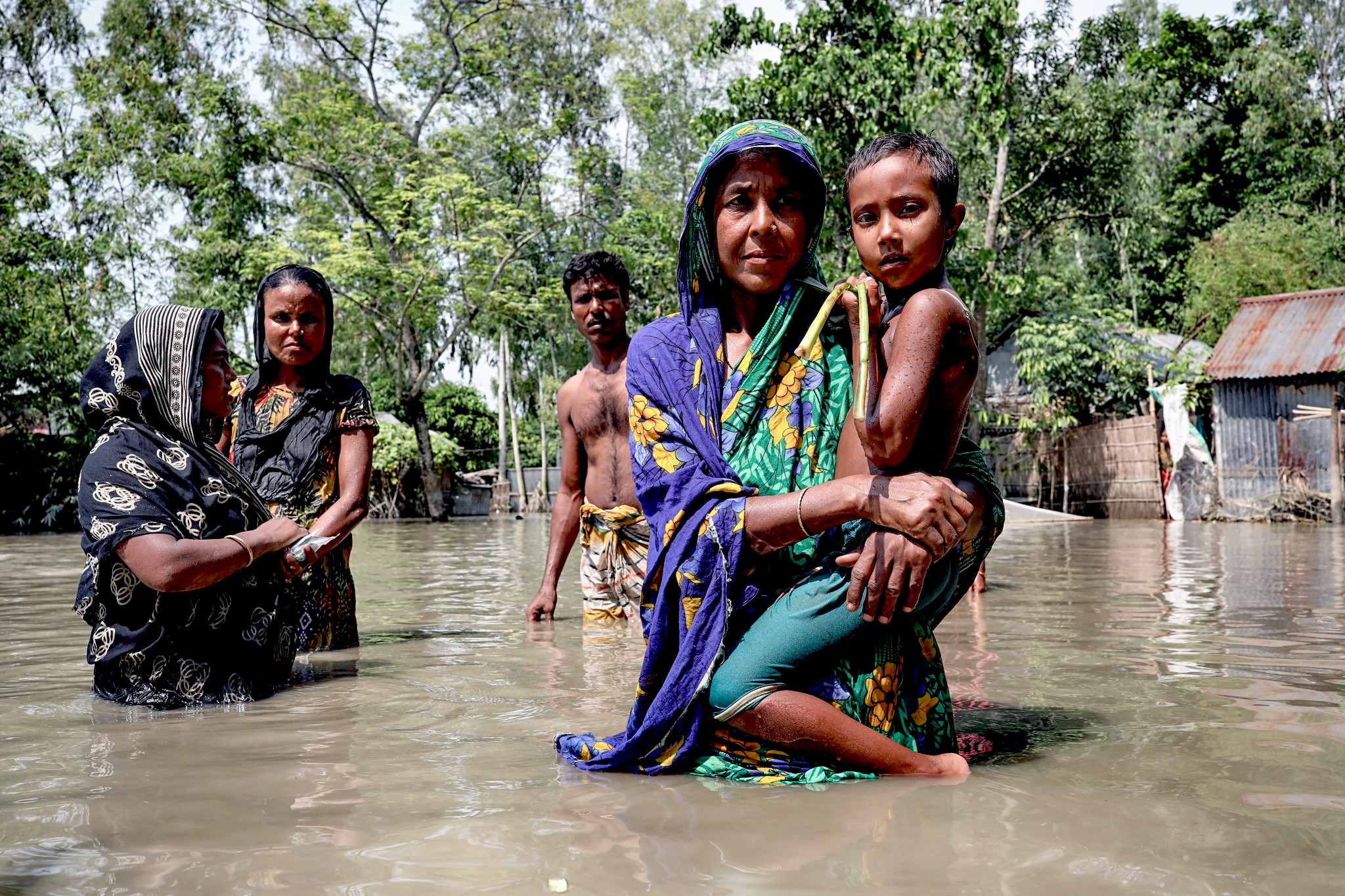Globally, as much as $3.8 trillion must be invested every year to hold back global warming, write Peter Schlosser and Michael Dorsey. For comparison, the IMF says $5.9 trillion was spent on fossil-fuel subsidies, in total, in 2020.

Installation at the COP 27 “Green Zone,” Sharm el-Sheikh, Egypt, November, 2022. (UNclimatechange, Flickr)
By Peter Schlosser and Michael Dorsey
in Sharm El-Sheikh, Egypt
Inter Press Service

 Climate change is an existential threat to humans and our ability to thrive on a healthy planet. But when it comes to rising temperatures, the inability of humankind to slow emissions and limit warming to 1.5 degrees Celsius isn’t because we lack knowledge or need new technologies.
Climate change is an existential threat to humans and our ability to thrive on a healthy planet. But when it comes to rising temperatures, the inability of humankind to slow emissions and limit warming to 1.5 degrees Celsius isn’t because we lack knowledge or need new technologies.
Consider: Humans have been warned for more than a century about the dangers of a warming climate and its adverse impact on human health and planetary systems, including but not limited to loss of biodiversity, decreased soil and ocean health, increased sea-ice melt and corresponding sea-level rise, and amplified disasters such as hurricanes, floods, heat waves and droughts.
Fifty years ago, “The Limits to Growth” warned humans of the serious need to live in balance with Earth’s systems. The science is settled. Likewise, technologies that drastically reduce greenhouse gas emissions are available and increasingly cost-competitive — particularly in energy production and transportation, two of the most significant contributors to global emissions.
[Related: COP27: Limits to Growth — Inconvenient Truth of Our Times]
What is missing? This is not a difficult physics equation. While we live in a complex world, the laggards in this area are observable: money and societal will.

People in Mymensingh, Bangladesh, whose homes were destroyed by flooding, July 2019. (UN Women/Mohammad Rakibul Hasan, CC BY-NC-ND 2.0)
In the global negotiations at the 2022 United Nations Climate Change Conference in Sharm El-Sheikh, Egypt, typically referred to as COP27, success will depend on the ability of the negotiators to mobilize investments and advance policy at the conference to accelerate opportunities for progress in altering the trajectory of climate change.
Even discussions on “loss and damage” — a signature issue of this conference that is historically neglected — are defined by these two needs. Underlying the issues of loss and damage are questions about processes for addressing loss (policy) and determinations of who is financially responsible (investment).
The price tag to address climate change is not small, but viewed in the right frame, it is a bargain. Take climate-enhanced disasters. In 2021, the world experienced four mega weather events that each cost $20+ billion in economic loss: Hurricane Ida, flooding in Europe, flooding in China and unprecedented winter weather in Texas and parts of Mexico.

Long Island Expressway in New York City shut down due to flash flooding from post-tropical storm Ida’s landfall, Sept. 2, 2021. (Tommy Gao, CC BY-SA 4.0, Wikimedia Commons)
These types of human-induced disasters are now increasingly frequent, occurring at more places and at higher amplitudes, and are more costly without considerable investment to curtail rising greenhouse gas emissions. At the 5th High Level Ministerial Dialogue on Climate Finance [on Nov. 14] ministers discussed achieving the annual $100 billion support mark for lower-income countries, a total those countries already note as too little, too late. The real need is in trillions of dollars, not billions.
The Intergovernmental Panel on Climate Change estimates that globally, $1.6-3.8 trillion must be invested every year through public and private climate-related finance to keep warming well below warming beyond 2 degrees Celsius. For comparison, the International Monetary Fund reports that fossil-fuel subsidies in 2020 were $5.9 trillion when summing up explicit and implicit subsidies.

Morning after Hurricane Maria in Dominica, Sept. 9, 2019. (Roosevelt Skerrit, Wikimedia Commons)
Combining policy with public investment can dramatically amplify results. The U.S. Inflation Reduction Act, the country’s most dramatic attempt to reorient its infrastructure and electricity production to lower emissions, could spend as much as $800 billion in tax credits, spurring on private investment to the tune of $1.7 trillion over the next decade, according to a Credit Suisse review of the policy.
The same report estimates that with the manufacturing and consumer tax credits, the cost of solar electricity could fall below one U.S. cent per kilowatt hour, possibly as soon as 2025. The investment bank declared that the U.S. Inflation Reduction Act “definitively changes the narrative from risk mitigation to opportunity capture” for corporations to take advantage of the law’s positive impact on the economy.
We have fallen behind the timeline set by the Paris Climate Accords and the 1.5 degrees Celsius target no longer seems to be achievable. The international negotiations must push the agenda to define aggressive mitigation policies, with incentives and disincentives, to scale known solutions on the fastest timescales possible for manufacturing and distribution throughout the world.
This needs real investments, private as well as public, for a chance to prevent the worst impacts of climate change. The time is now to show the most marginalized countries the money.
Peter Schlosser is one of the world’s leading earth scientists, with expertise in the Earth’s hydrosphere and how humans affect the planet’s natural state. He is the vice president and vice provost of the Julie Ann Wrigley Global Futures at Arizona State University.
Michael Dorsey is a globally recognized expert on sustainability, finance, renewable energy and environment matters. He is the chair of the Rob and Melani Walton Sustainability Solutions Service at Arizona State University.
This article is from Inter Press Service.
The views expressed are solely those of the author and may or may not reflect those of Consortium News.

What the U.K. independent news service says about COP27 is so correct: COP27 means “27 COLOMIAN PESOS.” Egypt’s dictatorship and the world’s corporate fossil fuel companies that took it over to make it a mall were the most responsible.
The very ones we are taught to rely on are the very ones screwing us.
It is thermodynamically impossible – i.e. against the laws of physics – to run metal and other resource extraction, manufacturing build out, maintenance, and heavy transport processes needed to build “[…] technologies that drastically reduce greenhouse gas emissions [which] are available and increasingly cost-competitive — particularly in energy production and transportation […]” that Peter Schlosser and Michael Dorsey appear to believe in their above article.
Diesel is 40 or so times more energy dense than massive heavy batteries that would need constant recharging via 1000kms long copper cables in distant remote areas, so its not possible to do any of these process without fossil fuels.
For example, geologist, miners, and financial markets all tell us: existing mineral & material supplies are orders of magnitude too small and would need decades to expand to support significant growth of ‘Modern Renewables’ i.e. building and connecting up machines to harvest low energy density wind, water & solar energy flows. There’s barely enough minerals to go around for existing demands in non-energy industrial production sectors already. Further, remaining reserves and futures are rapidly hitting geopolitical supply limits too. For example Russia and China dominate supplies of dozens of critical metals. Russia is among the three biggest sources of palladium, scandium and titanium, produces one-tenth of the world’s nickel, and six per cent of its aluminium all essential to build wind water & solar low energy density flow harvesting machine, their backups and distribution infrastructures. Demand for other critical minerals and metals – such as lithium, graphite, nickel, cobalt and copper – is exploding as demand climbs for everything from smartphones and laptops to wind turbines, solar panels and electric cars. China is supplies 60 per cent of the world’s rare earth elements, 82 per cent of the graphite, 14 per cent of the lithium, and nine per cent of the copper.
“Simply put, there is no energy transition without critical minerals, and this is why critical mineral supply chain resilience is an increasing priority for advanced economies,”
The Geological Survey of Finland published Mining of Minerals and Limits to Growth in 2021 with yet more research concluding the same mineral shortages story once again: “Global reserves are not large enough to supply enough metals to build the renewable non-fossil fuels industrial system or satisfy long term demand in the current system. Mineral deposit discovery has been declining for many metals. The grade of processed ore for many of the industrial metals has been decreasing over time, resulting in declining mineral processing yield. The implication is increase in mining energy consumption per unit of metal.
Mining of minerals is intimately dependent on fossil fuel based energy supply. Like all other industrial activities, without energy, mining does not happen. It becomes highly relevant then to examine how mining ecosystem interacts with the energy ecosystem. This suggests that the mining industrial operations to meet metal demand for the future are unlikely to go as planned. This implies that the current Linear Economy system is seriously unbalanced and is not remotely sustainable. It is clear that society consumes more mineral resources each year. It is also clear that society does not really understand its dependency on minerals to function.
There’s plenty of minerals still left in the ground, but the deposits that are easiest to extract have already been mined. For example “Over the past 15 years, the copper ore content in Chile’s mines has fallen by almost a third to 0.7 percent. Three generations ago, that figure was 2 to 3 percent. Today, the industry has to dig much deeper to extract the same quantities of precious metals than it did in the past – and it consumes correspondingly more electricity and fuel.” The same is true for all material inputs such as lithium, cobalt, aluminium, indium, tellurium, platinum, rare earth metals, and even building sand.
Meanwhile, electricity supply is only 9% to 15% of global primary energy consumption. So the correct question to focus on, bearing in mind all the limits identified by those who are paying attention, is how do we convert global energy consumption dominated by 85% fossil fuels, much of it hard to electrify industrial process heat & transport, to 100% electricity, without global populations returning to pre fossil fuel age numbers of around 1 billion by end of this century, given we’re past half way through known fossil fuel supplies and are now rapidly falling down the Seneca cliff side of the bell curve extraction cycle?
It’s the same old story – the many struggling against the greed, selfishness, ignorance and stupidity of the few. The few that wield their power as weapons against the many that want to save humanity, and its planetary home, from the destructive effects of their behaviour.
It’s the classic – good versus evil struggle, but this time it is existential, although the evil few don’t accept this fact. They refuse to understand the consequences of their rapacious behaviour over the last two centuries – the consequences of unbridled capitalism.
One of the terrible ironies, to me anyway, is that the evil few really think that they are the civilised and enlightened ones, and that the many are the ignorant fools causing all the problems. Individuals like Bill Gates come to mind – an enormously wealthy and powerful man who thinks he is saving the world with his so-called philanthropy, but is in fact making many of the problems worse – particularly in health and agriculture.
If we took the $5.9 trillion in fossil-fuel subsidies, and added it to the vast sums spent on weapons, war and ‘defence’ there would be enough to transform the world in a few short years, and even perhaps reverse some of the damage eventually.
The money is there, but the willingness to use it wisely is not.
WillD, Exactly what and how do you think engineers and manufactures can “transform the world” ?
Money can not purchase what is not available. Even if “we took the $5.9 trillion in fossil-fuel subsidies, and added it to the vast sums spent on weapons, war and ‘defence’ ” input minerals to “transform the world” will not magically appear out of thin air.
As I out line in my post above, there is no where near enough minerals and energy available in the future on this pale blue dot for 8 billion humans to exist over the coming half century or so, even if we shared it all out evenly. So its meaningless to argue that “$5.9 trillion in fossil-fuel subsidies” should be diverted to buy things that do not and can never exit.
Further to tie one’s world view to “$ trillions” being the only impediment to being able to “transform the world” declaring “The money is there” is to be imprisoned in the very same “unbridled capitalism” world view and its embedded key concept that ‘money can buy anything’ which you (and I) so despise.
Further still, since central banks create money at will, they do this all day long, every day there is NEVER any shortage of ‘money’, which is simply numbers on spread sheet double entry bookkeeping. Taxes do not fund spending. And neither would redirecting fossil-fuel subsidies (ignoring any inflation affects). Read Michael Hudson, Steve Keen, Bill Mitchel, David Graeber, etc. for more.
What is lacking in all of this is the hegemonic and murderous drive of US policies around the world to control the world’s resources and and each individual sovereign nation that refuses debt to privatize rather than nationalize its resources for the benefit of its peoples, is an enemy, of the USA. Every nation that insists on owning its own resources is an enemy of the good old US of A. Am I missing something?
When the US talks about bringing ‘democracy’ and ‘human rights’…it is nothing but hot air (no wonder our air is so polluted). Take a look at a world map and, seeking out the countries rich in natural resources, there you have the next US target. When the US offers to help, it has already figured ways to benefit from this ‘help’. The altruism is really touching.